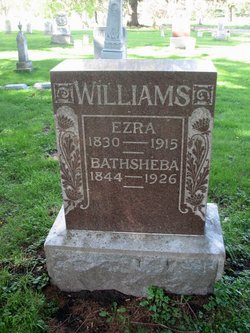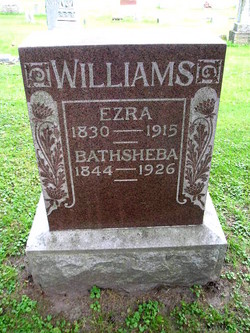| Description |
: |
father: Abraham Williams
mother: Mary Hike
marriage: 20 December 1885 Bremer, Iowa
spouse: Bathsheba Baskins
parents: Abner B. Baskins, Mary Kerr
Census 1885 Jefferson, Bremer, Iowa
Bathsheba Baskins F 41
Mary Baskins F 77
Ezra Williams M 54
Census 1900 Lafayette Twp, Bremer, Iowa
Age 70
Marital Status Married
Race White
Years Married 15
Birth Date Sep 1830
Birthplace Pennsylvania
Marriage Year (Estimated) 1885
Father's Birthplace Connecticut
Mother's Birthplace New York
Ezra Williams Head M 70 Pennsylvania
Bathshebe Williams Wife F 56 Ohio
The history of the pioneer settlement...
Read More
|
father: Abraham Williams
mother: Mary Hike
marriage: 20 December 1885 Bremer, Iowa
spouse: Bathsheba Baskins
parents: Abner B. Baskins, Mary Kerr
Census 1885 Jefferson, Bremer, Iowa
Bathsheba Baskins F 41
Mary Baskins F 77
Ezra Williams M 54
Census 1900 Lafayette Twp, Bremer, Iowa
Age 70
Marital Status Married
Race White
Years Married 15
Birth Date Sep 1830
Birthplace Pennsylvania
Marriage Year (Estimated) 1885
Father's Birthplace Connecticut
Mother's Birthplace New York
Ezra Williams Head M 70 Pennsylvania
Bathshebe Williams Wife F 56 Ohio
The history of the pioneer settlement of Bremer county would be incomplete were there failure to make mention of the career of Ezra Williams, who came to this part of Iowa in 1854 and whose residence here consequently covers the most important period of development and growth. For many years he engaged in the carpentering business in Waverly and was for twenty years the proprietor of a farm near the city, and his interests were carefully and capably conducted, bringing him a competency which now enables him to live in retirement. He was born in Bradford county, Pennsylvania, September 17, 1830, and is a son of Abraham and Mary (Heich) Williams, the former a native of Connecticut and the latter of Livingston county, New York. The father removed to the Empire state when he was a young man and there engaged in farming until he went to Pennsylvania. From the latter state he moved to Illinois in 1839, landing in East St. Louis and going thence to Madison county, where he remained for some time. He next moved to Lafayette county, Wisconsin, and then took up his residence on a farm near Oshkosh. This property he developed and improved for several years and then returned to Lafayette county where he engaged in agricultural pursuits. In 1856 he came to Waverly, taking up his residence here when the city was a small village. He purchased a number of lots and upon one of them built a residence in which he lived practically retired until his death, which occurred in 1866. He had long survived his wife, who passed away in the vicinity of Highland, Illinois. In their family were nine children, of whom the subject of this review is the seventh in order of birth.
Ezra Williams acquired a limited education in the public schools of Highland, Illinois, and following the completion of his studies worked as a farm hand in that state. When yet a youth he went to Lafayette county, Wisconsin, driving overland, and there engaged in farming in the employ of others until about 1848, when he went to work in the pine woods near Oshkosh. He afterward was employed in the pineries on the Wolf river for some years, engaged in logging, and eventually returned to Lafayette county. There he purchased and broke a team and engaged in breaking prairie land for others and also worked at the carpenter's trade. He continued thus until 1854, when he came to Iowa, making the trip from Dubuque to Des Moines, on the old military road. Mr. Williams had two yoke of oxen and was carrying with him thirty bushels of wheat, thinking that this article would be scarce in the frontier district to which he was traveling. However, he found that flour and wheat were cheaper in Bremer county than in Wisconsin and so sold his thirty bushels in Iowa City. Mr. Williams fell in with a band of emigrants coming west and the party enlivened the journey by frequent dances on a space cleared of leaves and brush, Mr. Williams furnishing the music for the dance upon his violin. After crossing the Iowa river the party divided, the subject of this review journeying toward the Big Sioux river. However, he met a party of people returning from that region who gave discouraging accounts of the conditions there and in consequence of this he changed his course, striking northeast toward Beaver Grove, where New Hartford now stands. He journeyed thence to Shellrock and on to what is now Marble Rock, where there were at that time but two settlers. A few days later he struck across the prairie again for the Cedar river, traveling through grass which stood higher than a man's head. His brother-in-law, who was also of the party, was just behind him and the journey was being accomplished successfully, when without warning fire broke out upon the prairie and spread around them with alarming rapidity. The men whirled their teams and made for the turned ground, succeeding in gaining it principally because the wagon covers broke the current of the air carrying the flames. The party gained the Cedar river at a point where Nashua now stands and journeyed down the stream to a point four miles north of Waverly, where Mr. Williams remained throught the winter of 1854. He began working at the carpenter trade and also traded to some extent in real estate, buying lots upon which he would build a house and afterward disposing of the improved property. He gave a great deal of attention to the contracting and building business, following that occupation during the summer months and during the winters operating the Waverly sawmill. Mr. Williams built the third house on the west side of the river but he considered at that time the future of the town as uncertain and had an idea of later converting his holdings there into a small farm. Later, however, he sold half of the ground to a Mr. Case and at the end of two years moved with his family to a hotel in Waverly, where he resided while working at carpentering. Soon afterward, however, he finished a house on three lots where the gas plant now stands and he moved into this residence, his sister keeping house for him. At the end of two years he sold the property and removed to a place east of the town, where he operated a farm for his wife's mother for some time. After his marriage he bought what was then known as the Fuller farm and upon this property engaged in agricultural pursuits for twenty years thereafter, becoming one of the progressive, representative and successful farmers of this locality. Through his well directed labors he succeeded in accumulating a gratifying competency, which enables him to live retired. He has bought a fine home on North Oak street in Waverly and expects to spend the remainder of his life in this house, having earned a period of rest and comfort by earnest and faithful labor in the past.
On the 20th of December, 1885, Mr. Williiams was united in marriage to Miss Bethsheba Baskins, a daughter of Abner and Mary (Kerr) Baskins, the former a native of Greene county and the latter of Washington county, Pennsylvania. The father went to Ohio when that state was still a wilderness and cleared one hundred and thirty-five acres of land, upon which he resided until 1852, when he came overland to Bremer county, Iowa, taking up government land in Jefferson township. He there engaged in general agricultural pursuits until his death, which occurred in 1864. His wife survived him a number of years, passing away in 1884. To their union were born eleven children, five of whom are living: William, a resident of Waverly; Abner; Rachel, who resides in northern Minnesota and who is the widow of Farn Dudgeon; Bethsheba, wife of the subject of this review; and Hannah, who married Edward Rose, of Spencer, Clay county, Iowa.
Mr. Williams gives his political allegiance to the democratic party and served as the second city marshal of Waverly. This, however, is the only public office he has held, having constantly refused political honors, although he takes an intelligent and active interest in public affairs. He was one of the first settlers in Bremer county, and has many interesting reminiscences to tell of frontier days existence. He shot deer on the banks of the Cedar river and has seen deer grazing where the Waverly sugar factory and brewery now stands. He can remember going into the cabin of "Little John", a famous hunter and a well known United Brethern minister, residing seven miles from Waverly, and seeing deer carcasses stacked up at one end of the house, the pile reaching from the floor to the rafters. At one time, in association with a friend, Mr. Williams bought some remnants of calico and shirting and they journeyed up the west fork of the Shell Rock river, selling their goods. They found the houses few and far between and, there being no roads, were obliged to use a compass in order to establish the course on which to proceed. On their journey they came to what is now the city of Hampton, then a small cluster of log cabins. One of these, the last on the west fork of the river, was occupied by a man named Hogan, with whom the travelers remained for three days while looking over the country. They saw an abandoned body of a house which had been partly erected and then left, the owner having been frightened away from his claim by Indians. This deserted dwelling in time became a shelter for elk, deer and other animals. Upon one exploring expedition Mr. Williiams and his party came upon what they thought at first was a band of Indian ponies but which later turned out to be a herd of elk. The only weapons in the party were a double-barreled gun and a target rifle belonging to Mr. Williams. He crawled around an elevation of land and through the rushes which stuck up through the ice on which the elk stood and crept so close to the band that he could easily count them, there being one hundred and six head. Mr. Williams fired at the animal nearest to him and the instant it dropped the whole band of one hundred and six began gathering around their wounded comrade and were later joined by another herd numbering about one hundred. The exploring party were in grave danger of a stampede and were only saved by a storm which came on, the snow falling to a depth of more than three feet. About two years after this adventure Mr. Williams with his father and a Mr. Vandervere went to the Des Moines river with a wagon drawn by an ox team and returned in the same manner to Hampton, the compass being their only guide. One night during this journey, when they had reached Wah lake Mr. Williams and Mr. Vandervere left Mr. Williams' father with the wagon and went out in search of wood but were unsuccessful on account of the heavy rain which was falling and were obliged to spend the entire night in the cold. They later found the Boone river and followed this stream during the morning, finding at noon sufficient wood to kindle a fire with which to cook a meal. Afterward they started in the direction of Humboldt county, Mr. Williams going ahead to part the grass, which grew higher than his head, and to blaze the trail. The party came to the Des Moines river at a point almost in the center of the county and found there a small settlement of two or three families. They had built their cabins along the river under the shelter of the banks, where they had found a series of waterfalls. Mr. Williams wished to utilize this place as a mill site but was unable to do so owing to the fact that it lay in a section which had been for purposes of improvement. The city of Hampton is now situated at that point on the river, the natural advantages which the site offered having led to the development there of a prosperous and wealthy community. After remaining in this settlement for three or four days Mr. Williams' father became homesick and the party returned to Waverly. Thus it may be seen that Mr. Williams faced all of the hard conditions of life on the frontier and became thoroughly familiar with pioneer conditions. Throughout the years which followed he saw this section change and grow, developing from a wilderness into a prosperous and populous community, rich in agricultural and industrial resources. In all of the work of progress he bore an active and honorable part so that today he is probably one of the best known citizens in this part of Iowa, being widely recognized as a man of tried integrity and worth, of business enterprise and unfaltering diligence. His fellow townsmen honor and respect him and wherever he is known he has an extensive circle of friends.
[History of Bremer County, Iowa Vol II 1914]
|



